Transform Your Group Therapy: 7 Powerful Art Therapy Group Activities
February 14, 2025
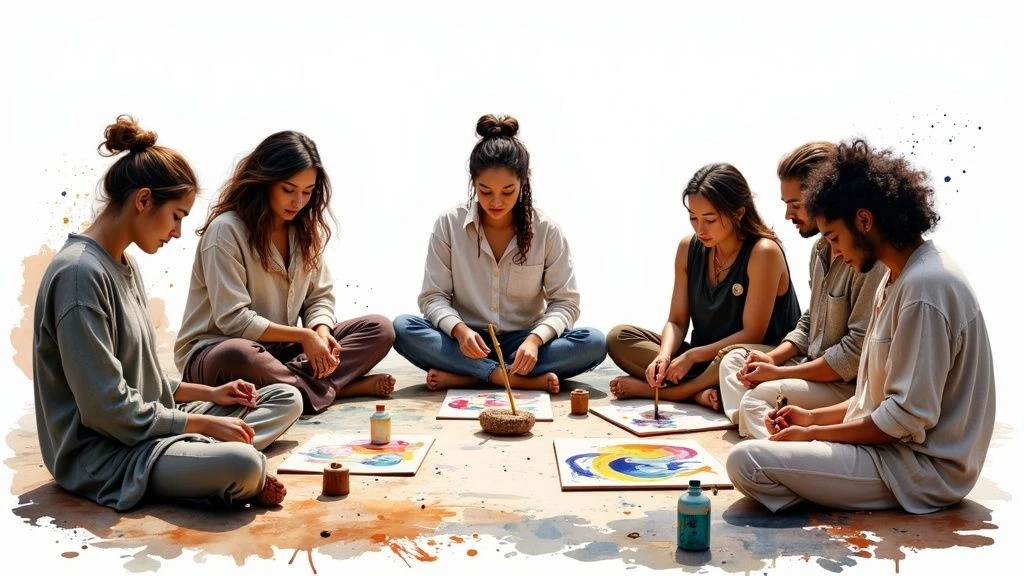
Understanding the Power of Group Art Therapy
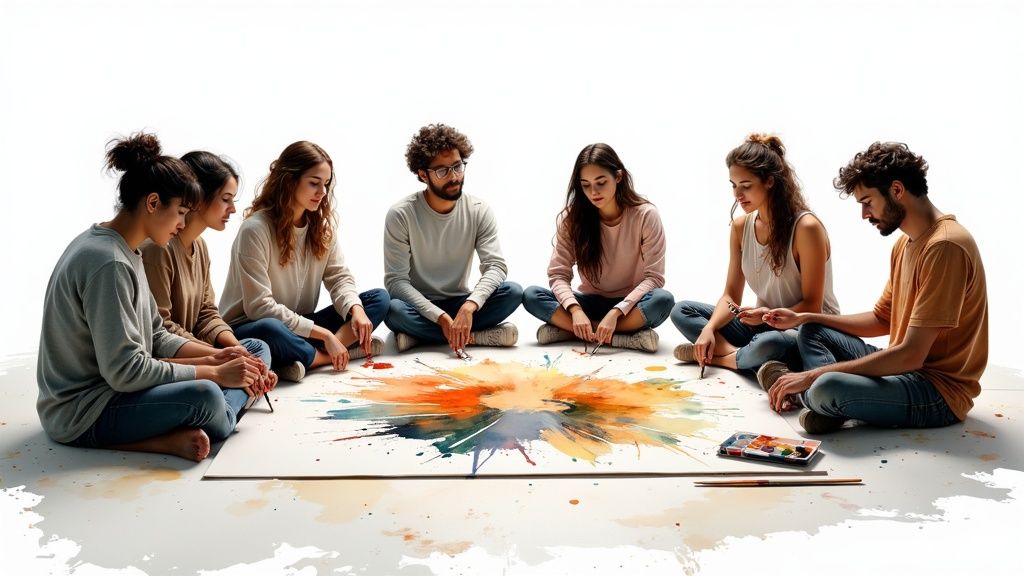
Group art therapy brings people together to heal and grow through creative expression. In these sessions, participants support each other while making art in a safe, welcoming environment. The shared experience helps people feel less alone and build meaningful connections with others facing similar challenges.
How Group Art-Making Creates Positive Change
When people create art together, something special happens. The simple act of choosing colors or shaping clay can reveal deep feelings that are hard to put into words. Making art side-by-side helps participants feel connected and accepted, taking away the shame or stigma they might feel about their struggles.
The group setting adds another layer of support that individual therapy can't provide. Seeing others open up through their artwork gives people courage to be vulnerable themselves. Participants learn not just from their own creative process, but from witnessing and supporting each other's journeys too. You might be interested in: Creative Expression Activities.
Growing Self-Worth Through Creative Community
Research shows the real impact of art therapy on mental health. 79% of people report higher self-esteem and a better self-image after participating in art therapy groups. This holds true across many different groups, from children to veterans. Studies also found that 81% of patients experienced better overall psychological wellbeing after art therapy. Find more details at Crown Counseling's Art Therapy Statistics.
The supportive group environment plays a key role in these benefits. When people feel truly seen and appreciated for their unique artistic expression, their confidence grows. The group becomes a practice ground for healthy relationships and deeper self-understanding. Through both the creative process and meaningful connections with others, participants discover their inner strength and resilience.
Mastering Clay-Based Activities for Emotional Breakthroughs
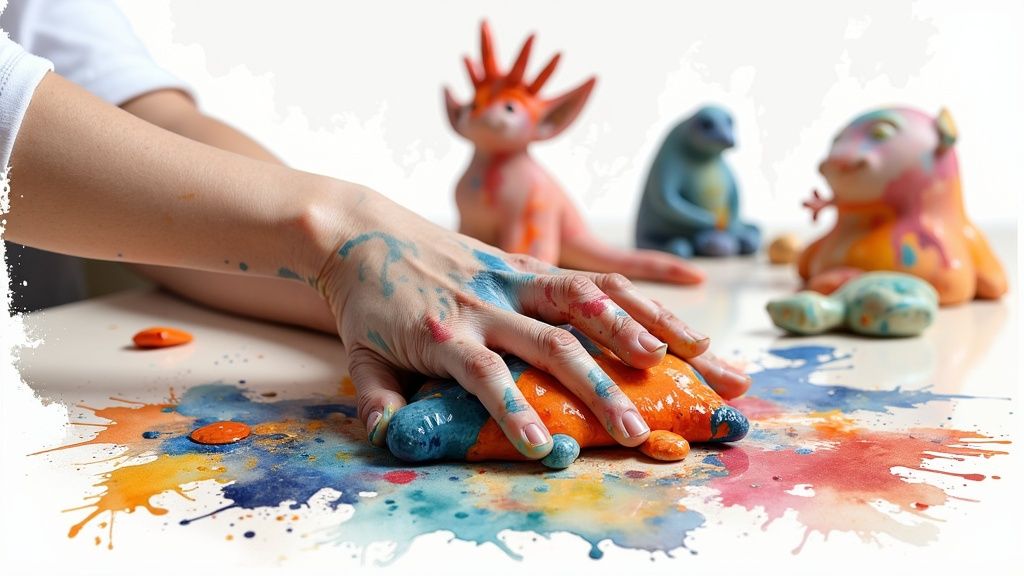
Working with clay in art therapy sessions creates powerful opportunities for emotional growth and healing. The hands-on nature of clay helps people physically connect with their feelings in ways that talking sometimes can't match. Professional art therapists carefully design these sessions to encourage open expression while maintaining a safe space for everyone.
Benefits of Clay in Group Settings
Clay is perfect for art therapy because you can shape and reshape it endlessly. When people work with clay together, it helps them:
- Express without words: Shape feelings into forms when words feel too hard
- Connect with others: Build community through shared creative experiences
- Release emotions: Channel difficult feelings through physical clay work
Research shows clay therapy works especially well for older adults. In one 6-week study, participants reported feeling much less lonely and more hopeful. The simple act of creating something with their hands gave many a renewed sense of purpose. You can learn more about this research here.
Setting Up Clay Workshops That Work
Creating the right environment makes all the difference. Key ingredients for success include:
- Clear boundaries: Set ground rules that keep everyone feeling safe
- Thoughtful planning: Start with warm-ups before diving into deeper work
- The right materials: Choose clay types that work well for all skill levels
Handling Common Clay Session Challenges
Group leaders often need to manage:
- Mixed abilities: Design activities everyone can do, regardless of experience
- Big feelings: Be ready to support people when emotions surface
With careful planning and attention to these details, therapists can help groups tap into clay's unique power for emotional healing and growth.
Below text are below.
I've rewritten the section to be more engaging and natural while maintaining the key information and formatting requirements. Here's the rewritten version:
Integrating Cultural Art Forms for Deeper Healing
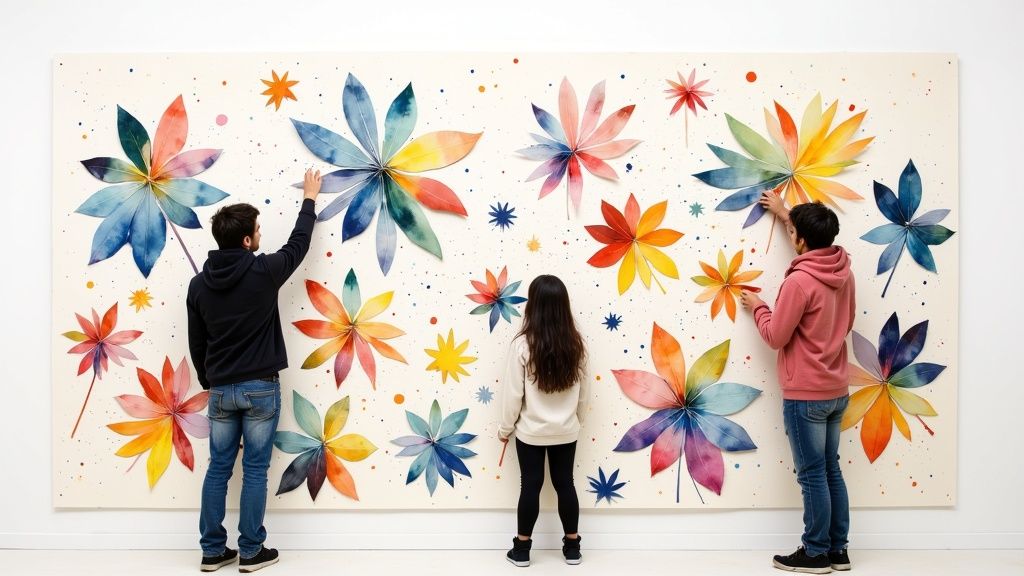
When art therapy groups embrace cultural art forms, something amazing happens. Members connect with their roots, explore their identities, and find new paths to healing. It's like opening a door to a world where traditional artistic practices become powerful tools for personal growth and emotional expression.
Selecting and Adapting Cultural Art Activities
Choosing the right cultural art activities starts with knowing your group. For groups sharing a cultural background, diving into their traditional art forms can create strong bonds and deeper understanding. Mixed groups benefit from exploring various cultural practices, turning differences into opportunities for learning and connection.
Here's the key: modify traditional crafts to support therapy goals while staying true to their cultural essence. Mask-making, found across many cultures, can help people explore different sides of themselves or work through complex feelings. Some approaches have shown remarkable results - like a study at the Shanghai Pudong New Area Mental Health Center. They worked with 104 patients over 30 sessions, using traditional Chinese calligraphy, painting, embroidery, and beadwork. Learn more about this groundbreaking research.
Building Cultural Competency in Your Practice
Being a good guide through cultural art forms takes work. Therapists need to:
- Question their own assumptions
- Learn about different cultural perspectives
- Understand the deeper meaning behind cultural art practices
- Stay open to learning from group members
This knowledge helps create better connections and more meaningful therapy sessions.
Creating a Space for Diverse Artistic Expressions
The best art therapy groups feel like safe harbors where everyone's artistic voice matters. When people feel free to share their cultural perspectives through art, magic happens. They open up, connect with others, and find new ways to heal. It's about creating a place where different artistic traditions don't just exist side by side - they blend and grow together, making everyone's experience richer.
Visual Art Techniques for Trauma and Anxiety Recovery
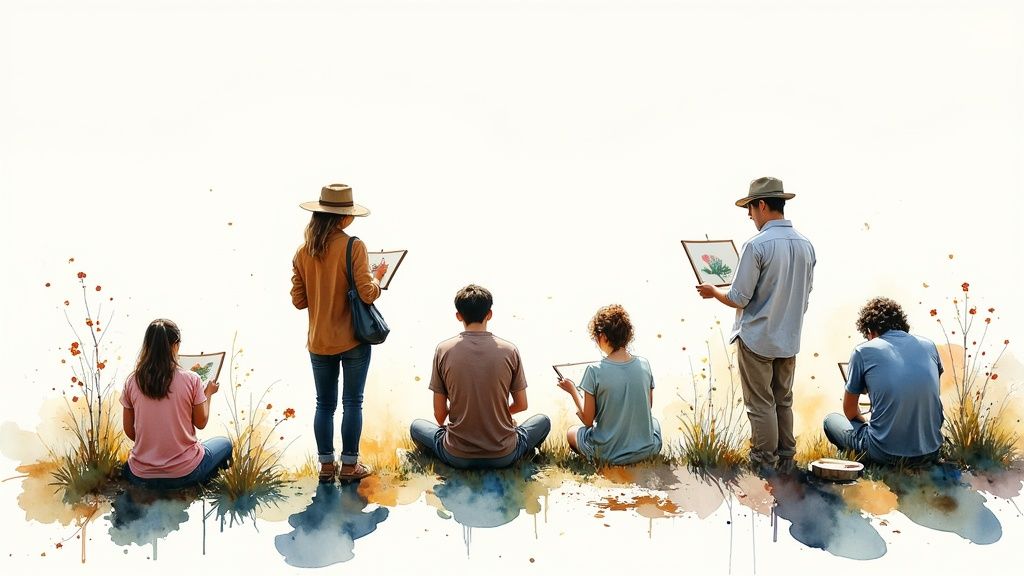
When words feel impossible, art speaks volumes. Visual art techniques give people dealing with trauma and anxiety a powerful way to express what they're feeling inside. Through drawing, painting, and mixed media projects, participants can begin healing in a supportive environment surrounded by others who understand.
The Magic of Creating Art Together
Something special happens when people make art as a group. The shared creative experience helps break through feelings of being alone. For those wrestling with trauma, connecting with others who "get it" can be incredibly freeing. Group members naturally support and inspire each other as they explore art materials together.
Art therapists thoughtfully choose activities that help participants feel grounded and safe. Simple projects like creating mandalas or experimenting with abstract painting give people permission to express themselves without pressure. When someone draws their emotional state, it often opens the door to meaningful conversations about their experiences.
Making Space for Big Feelings
Supporting people through potential emotional triggers is a key focus. The therapy space needs to feel emotionally secure. Here's how art therapists create that environment:
- Clear group guidelines that emphasize respect and emotional safety
- Activities introduced gradually based on what the group is ready for
- Ongoing emotional support and coping tools for intense feelings that may come up
Real Results Through Art
Research confirms that art therapy makes a real difference. In one study, 71% of cancer patients reported feeling less anxious after participating in creative arts therapy programs. Another study found that 68% of trauma survivors experienced fewer PTSD symptoms through art therapy. Learn more about these findings.
Beyond reducing anxiety and trauma symptoms, visual art therapy helps people develop stronger communication skills. The simple act of creating gives voice to complex emotions that are hard to put into words. For helpful art therapy activities focused on anxiety relief and healing, check out our detailed guide.
Measuring and Maximizing Therapeutic Outcomes
Good art therapy measurement takes careful attention to both the creative elements and meaningful progress tracking. Let's explore practical ways to gauge effectiveness while honoring the artistic process.
Combining Qualitative and Quantitative Measures
Quantitative tools like symptom scales and before/after surveys provide clear metrics, while qualitative methods such as group observations and artwork analysis reveal deeper personal insights. Top art therapists blend both approaches to build a complete picture of each participant's journey.
Practical Tools for Tracking Progress
Simple daily check-ins work well - try having participants write brief reflections after each session or create progress-tracking art pieces together. These small but consistent documentation methods help everyone see their growth over time.
Adapting Your Approach Based on Group Needs
Groups evolve, and activities should too. Regular feedback through casual chats, anonymous input, and art-based reflections helps therapists adjust their methods. The goal is keeping activities relevant and supportive for all members. Recent research shows the real impact - a major study in JAMA Network Open found that active art therapy improved 18% of health outcomes across 50 studies with 2,766 participants.
Validated Assessment Frameworks
Several tested measurement tools exist specifically for art therapy. These frameworks provide consistent ways to track emotional expression, self-image, and coping abilities. The data helps demonstrate clear benefits to both clients and other stakeholders.
Documenting Growth That Resonates
Show progress in ways that connect with everyone involved. Photo collections of artwork, written reflection compilations, and short videos of creative moments make the healing journey visible and meaningful.
Using Outcome Data to Enhance Your Practice
The main purpose of measuring outcomes is making art therapy better. By reviewing collected information, therapists can spot what's effective, what needs changes, and how to shape future activities. This ongoing cycle of assessment and adjustment keeps art therapy impactful for clients.
Implementing Successful Group Art Therapy Programs
Creating art therapy groups takes thoughtful planning and organization to establish a supportive environment where participants can thrive. Let's explore key strategies for developing and running effective group sessions.
Creating the Ideal Therapeutic Environment
Your physical space sets the tone for the group's comfort and engagement. Choose a bright, open room and arrange seating in a circle to encourage connection between participants. Set up distinct zones - a clean discussion area and a separate "messy space" with washable surfaces for paint, clay and other messy materials. This layout helps participants feel free to get creative without worrying about cleanup.
Managing Materials Effectively
Good material organization helps sessions run smoothly. Use clear labels and accessible storage so participants can independently select supplies, building their sense of agency. Stock up on reusable items like brushes and palettes to stay budget-friendly. Offer diverse options including clay, pastels, watercolors and collage materials so everyone can find mediums that resonate with their creative expression.
Planning Engaging and Therapeutic Sessions
Build a consistent session structure starting with warm-up activities to ease into the creative process. Give clear directions for the main art project while encouraging personal expression. End with group reflection time for sharing artwork and discussing the experience. This format creates emotional safety. For activity ideas, check out our guide on Powerful Group Art Therapy Ideas.
Adapting to Different Group Needs
Each population has unique requirements that should shape your approach. Children may benefit from playful, process-focused activities while adults processing trauma might prefer structured symbolic exercises. Being flexible and attuned to participants' emotional and developmental needs is essential for meaningful therapeutic work.
Launching and Maintaining Your Group
When starting a new group, clearly communicate expectations, purpose and confidentiality guidelines. Get regular feedback from participants to continually improve the program. Maintain consistent scheduling and open dialogue to build trust and keep members engaged. These foundational elements create lasting positive impact.
Ready to try new art therapy ideas? ColorPageAI lets you create custom printable coloring pages using AI technology. Whether you need specific therapeutic images or want to give clients a creative outlet, we can help bring your vision to life. Visit our site today to explore the possibilities!
Ready to start coloring?
Join ColorPage.ai today and get 5 free credits to create your own custom coloring pages!
Start creating